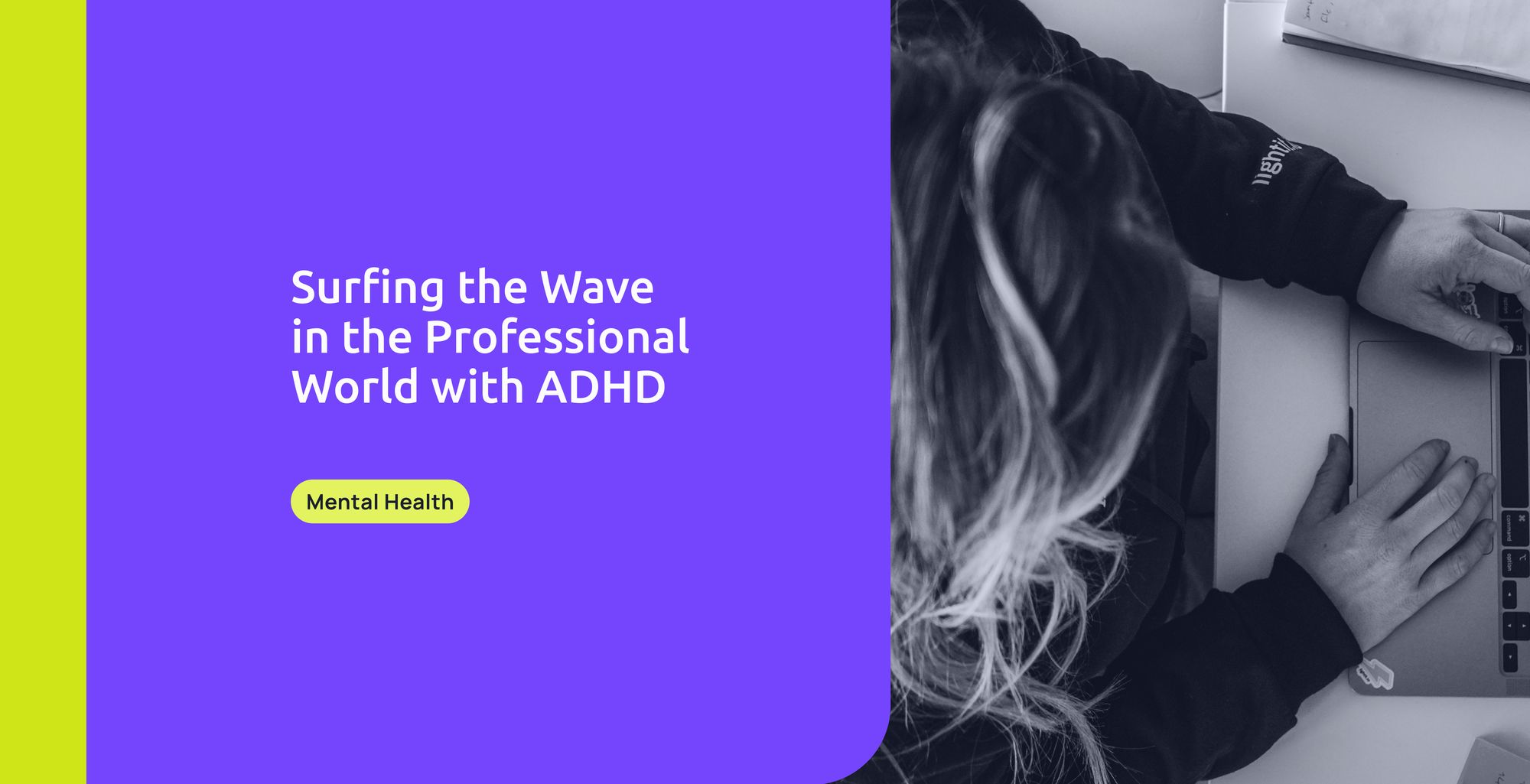Anxiety, hyperactivity—these terms are everywhere nowadays. Still, they are not new to me; they've been with me since childhood, and now, as a professional and a mother, they present even more challenges.
How did I navigate life with these symptoms so deeply ingrained in my being? Let me share a glimpse of my journey.
A Brief Background on My ADHD Diagnosis and Journey
Growing up, I struggled with inattentiveness. I somehow still managed to be a successful student. In college, I also did well, even pursuing two university careers in parallel. Then, in my early career, I was resolute and proactive but never content enough with my results, which often made me take on more than I could handle. Now I know that, beneath that surface, I was masking ADHD symptoms with perfectionism and people-pleasing, leading to constant stress and exhaustion.
Although it appeared that I was cruising through life, my mind was (to put it mildly) overloaded on the inside. This meant feeling constantly stressed, hyperventilating, forgetting important activities, dates, and tasks, and struggling to manage my time effectively. Despite this, outwardly, I was seen as dependable and organized—a go-to person at work who always had things under control.
I didn't feel like things were falling apart until four years ago. I was stressed, overwhelmed, terribly forgetful, and exhausted—really exhausted.
What about depression, which is prevalent in women with ADHD? I almost broke from it before I got help from a specialist. It was like living in a fog of uncertainty, fearing that these struggles might seep into my personal and professional life more deeply than their subtle beginnings suggested.
I was not aware that these were symptoms of ADHD until I read an article (and listened to a podcast, and watched a documentary, and read a scientific paper and maybe something more, hyperfocus? Maybe 👀) and questioned my therapist about it.
What is ADHD, really?
The acronym refers to Attention Deficit and Hyperactive Disorder. Wow, it actually sounds bad. “Disorder”? Well, in fact, it is. Scientists explain it’s a neurodivergence. This means (according to Cambridge University) “having or related to a type of brain that is often considered as different from what is usual”. Read this: a report claimed that around 20% of high school students in America are neurodivergent. 20%, this is huge!
And how does it feel to live with ADHD?
Imagine the world in which you exist wasn't designed for you. It may sound dramatic, I know. But in this place, you're supposed to concentrate, remain silent, and sit quietly. In the meanwhile, your brain's making unexpected connections, constantly. It’s as if you can’t sit still, but you are! It can make you feel as though you're not succeeding in life. However, you are. Confusing to read? Imagine how it feels to live with it.
Closing the Gap: Symptoms and Signs of ADHD in Women
Because women often display ADHD symptoms differently from men, and historically, research on the disorder has primarily focused on men, many women remain undiagnosed.
So, I believe it’s important to share some common symptoms of ADHD in women:
- Inattentiveness and distractibility
- Hyperfocus on tasks of their interest
- Sensitivity and emotional dysregulation
- Perfectionism and people-pleasing tendencies
- Difficulty with time management and organization
- Procrastination and task avoidance
- Imposter syndrome and low self-esteem
- Hormonal and eating disorders
- Body dysmorphic disorder
Source: Ellen Littman, LCP; 2023
As I stated above, ADHD in women is frequently misdiagnosed, or in many cases, it goes untreated throughout their lives. Trust me, the gender gap is also big in the scientific world! Interested in the topic? Go and read this article; it was quite eye-opening for me.
Strategies for Thriving with ADHD in the Professional World
So, I usually apply the following -doable- tactics to control my symptoms, with differing degrees of success. I hope these are useful to someone!
- The good old “To do” lists
Ah, the trusty "To Do" lists – my faithful companions in the battle against forgetfulness and chaos. Every morning, I meticulously jot down every task, every call, and every important detail that demands my attention. Sure, I do use ClickUp to manage my team, and I'm also aware of the wonders of e-calendars with their automated alerts, but let's be real here – I'll probably just ignore the notifications in my hyperfocused state anyway. So, pen and paper is my friends, the tried and true method to keep my scattered brain in check.
- Lo-fi music
Lo-fi music (a mix of different genres, including hip-hop, jazz, and dream pop) typically has a slow tempo and is repetitive in nature. Its tempo aims to ease symptoms of anxiety, depression, and ADHD, promoting a sense of tranquility and enhancing mental well-being. Whenever I hit play on my lo-fi playlist, it's like stepping into a zen zone where my mind can finally relax and focus. It's my go-to soundtrack for getting stuff done!
Check out this playlist, I usually listen to!
- Moments of isolation
Sometimes, locking myself away in a quiet spot works like magic. It's just me and my work, no distractions in sight. I fully immerse myself in my work without anyone around to distract me. The lack of external stimuli prevents sensory overload, making it easier for me to maintain focus and productivity. This controlled environment gives me a sense of structure and clarity, which is essential for managing my symptoms and staying on track with my tasks. - Taking short breaks
Taking short breaks throughout the workday, whether it's chatting with colleagues, enjoying a cup of coffee or tea, or simply going for a quick walk around the block, can significantly boost productivity for individuals with ADHD. These breaks provide much-needed mental rest, helping to alleviate feelings of overwhelm and fatigue. Furthermore, engaging in brief social interactions or physical activity stimulates dopamine release, which enhances focus and motivation. By incorporating these regular pauses into our routine, we can maintain better concentration and overall performance. - Turning off business apps outside working hours
Disabling notifications outside of work hours can also significantly enhance productivity. I can better recharge and focus on personal activities by reducing distractions during leisure time. It also facilitates a healthier work-life balance. It minimizes the temptation to impulsively respond to emails or Slack messages, allowing for uninterrupted relaxation. I understand that in some cases, "duty calls" and it may not always be feasible to disconnect completely. But giving it a try can make a noticeable difference! You'll be able to approach the next workday with renewed energy and clarity.
Resources, Tools, and Apps to Manage ADHD
I also gathered a collection of helpful resources to help you understand better and deal with ADHD symptoms. There's a wealth of literature, scientific research, tools, and apps available to help us (thankfully!) that go from innovative apps to supportive communities. In the following list, you'll find some that worked for me:
- Flora App:
This app is actually fun, it uses the metaphor of planting and growing virtual trees to represent the time users spend focused on their tasks. Through a gamified dynamic, it helps you keep focused and off your phone.
- Evernote:
I use this app, both its desktop and mobile version, for organizing and managing my notes (exactly, exclusively my notes). It’s crucial to ensure that brilliant ideas don't slip away and can be easily retrieved when needed.
- Focus@Will:
I actually found this site while researching for this post, and it’s pretty cool. It provides personalized music channels scientifically designed to enhance focus and productivity for work or study.
- ToDoIst:
This app is helpful for effectively managing tasks, organizing projects, and staying on top of your to-do lists. It’s the digital version of the old-schooled pen and paper.
- ADHD is Awesome
This guidebook’s writers, Penn and Kim Holderness, adopt an alternative viewpoint rather than seeing the diagnosis as a curse or giving in to feelings of weakness or inadequacy. It offers simple-to-understand explanations, strategies, and resources from physicians, researchers, and professionals in an often hilarious manner.
- ADDitude:
This online magazine provides articles, webinars, and community forums, advice, support, and practical strategies to help individuals and families manage ADHD more effectively. They strive to empower readers with practical strategies, insights, and inspiration!
- ADHD Awareness:
This is an NGO focused on spreading the word and sharing info about ADHD. Their website is like a hub for learning and support, helping people understand ADHD better and pushing for better resources and treatments.
Wrapping it up
To help you manage ADHD, there are countless hacks, apps, and strategies. Most of these won't work for you, but a handful might. To experiment is okay. I mean, you should do it, in fact. But also, be kind to yourself!
Although it can be troublesome at times, it also has its particular perks, including inventiveness, creativity, problem-solving abilities, good energy, and the capacity to hyperfocus on things that you find appealing.
Start dialogues on ADHD with your coworkers, friends, and family and, as I recently read, “celebrate your beautifully complex mind”. Being self-aware and having a strong support system will help you succeed in both your personal and professional life.

